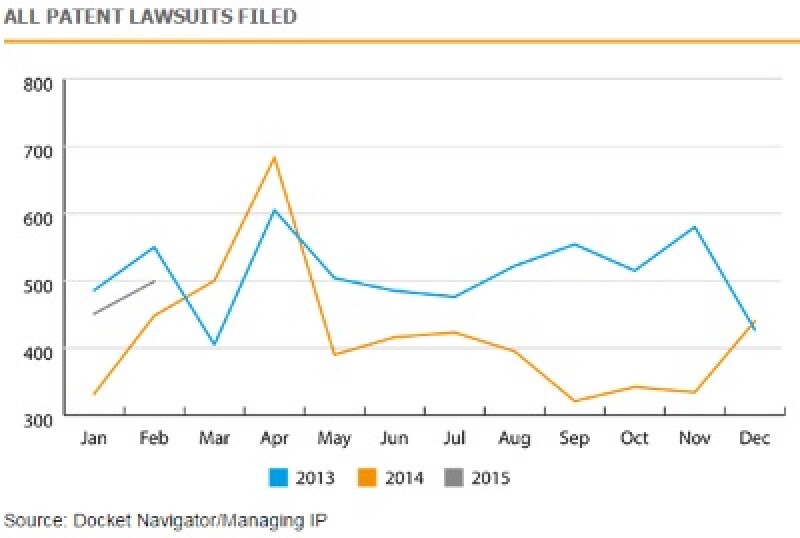
Managing IP’s just-published analysis of US district court patent litigation trends so far this year shows a clear trend: litigation is increasing.
February’s number of new patent cases filed was up 11% on January, which was up 2.5% on December. This continued the trend seen at the end of the 2014, when December lawsuits increased a whopping 32% over November.
It is only a month-on-month analysis that shows an increase. The trend is also up when compared with the same month in the previous year – 11% in February over February 2014, 36% in January and 3% in December.
(See my article US patent litigation surges in February, driven by software cases for a full breakdown of the figures and an analysis of how software cases are increasing at even faster rate – subscription or free trial required).
Three straight months of increasing patent litigation is a contrast to a few months ago when the Supreme Court’s June 2014 Alice decision, as well as the astonishing popularity of Patent Trial and Appeal Board proceedings, had appeared to put a dampener on lawsuit filing.
So what is going on? The frist thing to note is that, just as a few months of patent litigation trending down last year was not definitive proof of a long-term trend, a spike back up is not a sure sign of a lawsuit boom. The levels this year are still below 2013 levels.
But this year’s increase throws up some questions to which there are not yet clear answers to. For example, were plaintiffs merely pausing planned litigation to see how Alice would play out in the district courts? Were they taking time out to work out new litigation strategies that would not be affected by Alice before returning to the fray? Is the increase being driven by companies with a long history of litigation or by new companies?
February throws up some contrasts. It saw the continued return of ArrivalStar, the third-busiest NPE in 2013, following a pause in litigation for most of 2014. The company has filed nine lawsuits so far this year, following six lawsuits in November and December. In contrast, a company called Avioniqs filed 30 cases against airlines on February 6, its first ever patent lawsuits. And just yesterday Qommerce Systems sued 23 websites, alleging infringement of a "Dynamic web storefront technology" patent. It had filed its first ever patent lawsuits on February 17 when it sued 20 other websites.
An analysis from Unified Patents had an interesting tidbit to mull over. As with our analysis, Unified – which protects its members against NPEs – found that patent litigation in February was up, although its figures gave a 9% increase on January’s figures. But it also found: “NPE litigation made up 65% of February 2015 initiated district court cases, compared with 68% in February 2014 and 58% in January 2015.”
The pro-patent and anti-patent lobbies will be sure to argue about what it all means. I have previously argued on this blog that a pause before enacting any further reform would be wise, with litigation falling, the Supreme Court relaxing fee shifting standards under Octane and limiting the scope of patentable subject matter under Alice, and the PTAB shifting the balance of power more towards defendants in litigation and away from patent owners. I stand by that position, but reform supporters are sure to pounce on the recent increase in litigation as proof of the need for legislation.









